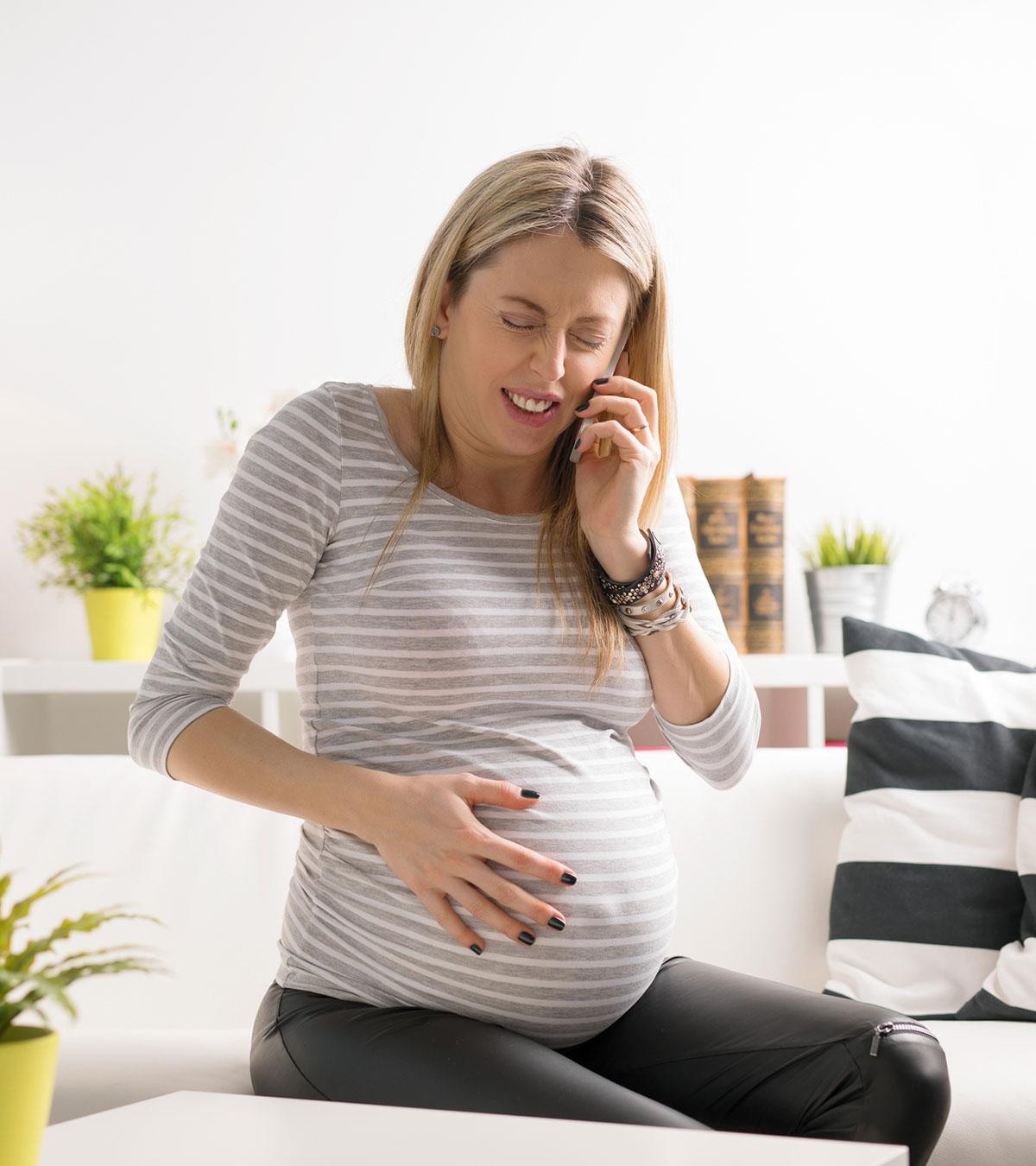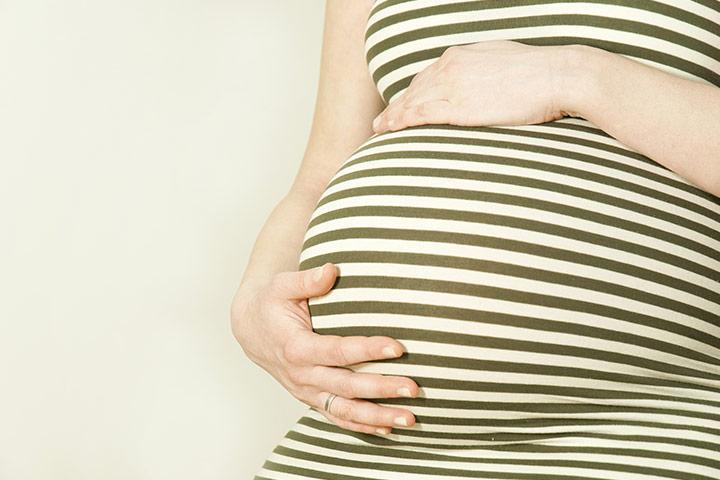
Image: Shutterstock
Because labor is uncertain, you begin to have doubts and lookout for signs of labor as your due date approaches. You may think with every cramp that if you’re having contractionsiTightening of uterine muscles, causing pain in the lower belly and back , or have questions like ‘what should I do if the water breaks?’ or ‘is my back pain a sign of labor?’ You may also have asked similar questions of other mothers and received different responses for each question. However, there are some evident indicators of labor. Continue reading to learn about some obvious signs and symptoms that signal labor.
When Does Labor Start?
In most cases, labor starts between the 37th and 42nd week of pregnancy. Labor that occurs before the 37th week is called preterm or early term; labor between 39th and 40th weeks is a full term; labor after the 42nd week is late term. About 60% of women go into labor on or before their estimated due date (1). If you go beyond 41 weeks, your practitioner may recommend labor induction (2).
You may begin checking for the signs of labor around your due date. However, note that the process of labor might begin way before your due date. Also, it is not necessary that you have all of these signs.
 Quick fact
Quick factSigns And Symptoms Of Labor Pain
, a Lamaze-certified childbirth educator from Redlands, California, says, “The usual signs that labor include increased vaginal discharge, partial or full loss of the mucous plug, mild cramps (which are actually contractions in disguise), and a trickle (or gush) of water.”
Labor comes after giving you enough alerts about its arrival. Here are some signs your body might give before labor. Each case is different and you may or may not have the same signs as other women did.
1. The baby “drops” (lightening)
When the body prepares for labor, the baby may settle deeper into the pelvis, making you feel lighter. There will be reduced pressure in the chest and abdomen, thus, making you breathe easily and eat a full meal (3).
However, it does not mean that labor is close. It will take a few more weeks. Moreover, first-time moms can have lightening earlier than experienced moms.
2. Nesting
As the name suggests, nesting instinct is the motherly instinct to build a haven for the baby. Amid those days of breathlessness, restlessness, and fatigue, you might suddenly feel energetic to get up and set the house in order, paint your baby’s room, or keep things ready for them. It is scientifically proven that nesting happens not only in other mammal species but also in humans (4).
3. Contractions get intense
One of the major signs of true labor is contractions. They will become longer and stronger as you get closer to labor. It is hard to figure out if they are real or false (Braxton Hicks) contractions. Here is how you can understand the difference:
| Real Contractions (True labor) | Braxton Hicks Contractions (False labor) |
|---|---|
| They start after the 37th week of pregnancy, and if they come earlier, they are the signs of preterm labor. | They start from the second trimester itself and appear frequently in the third trimester. |
| They are regular and follow a pattern. | They are irregular and do not follow any pattern. |
| They progress with time; become more frequent, stronger and longer. | They do not progress over time. |
| They begin from the lower back and radiate towards the groin region. | They are a generalized abdominal tightening. |
| Any activity or movement will not stop or lessen the contractions. | They disappear with any activity or movement. |
| Your waters may break. | Your waters do not break |
| The bloody show happens. | The bloody show will not take place. |
| Cervical changes occur. | No cervical changes. |
4. Cervical changes during labor
The cervix is the opening of the uterus through which the baby is born. All through the pregnancy, this opening is thick (not effaced), closed (not dilated), pointed towards the back (posterior end of the mother), and has a layer of mucus (mucus plug) to protect the baby. The below changes to the cervix signal labor:
- Thinning of the cervix (effacement): The cervix begins to thin and widen, indicating that the lower part of the uterus is ready for labor.
- Opening of the cervix during labor (dilation): The cervix opens to about 10cm just before labor.
You may not know or observe the changes to the cervix; the healthcare provider might check your cervix once you near the due date (5).
5. Bloody show
As the changes occur in the cervix, you will shed the mucus plug. It drops out in a lump or discharge for a few days. It is tinged with brown, pink, or red blood and therefore referred to as “bloody show”. This indicates that labor is close (6). But note that not every pregnant woman will have this symptom. If you notice the bloody show between 32 and 34 weeks, you should call your doctor as it can be a sign of preterm labor.
6. Water breaking
Spontaneous ruptured membranes or “breaking of the waters” is a strong symptom of labor. It happens when the amnioticiRelated to the sac and liquid that surrounds the embryo sac ruptures and the fluid gushes out from the vagina. Once the waters break, you should immediately contact your doctor (7).
 Did you know?
Did you know?7. Diarrhea
During the early stage of labor, the body releases prostaglandinsiA group of hormone-like substances that plays an essential role in human physiology , which soften the cervix and contract the uterus. They also stimulate bowel movement, naturally emptying the bowel to make way for the baby. This is a good sign as it helps clean out your tummy and avoid any discomfort during labor (8).
Symptoms such as diarrhea are generic and might happen anytime during pregnancy. Therefore, you do not have to panic about them. But if you observe more prominent signs such as water breaking, bloody show or frequent contractions, it could mean that you are nearing labor. You need to talk to the doctor without delay.
What Happens If The Waters Break Without Contractions?
If your water breaks but the contractions do not set in, your doctor may induce labor
. This is to prevent the baby from infection as the amniotic sac is no more present to protect the baby (9). Also, if you had a positive culture for group B strep (GBS), you will need antibiotics when the water breaks (10) to prevent the infection from passing on to the baby.
Charlene, a mother and blogger, surpassed her due date and was four to five centimeters dilated. Hence, the midwife broke her water, and later, she was induced. Recalling her childbirth experience involving induction, she says, “I was given Syntocinon (a synthetic form of the hormone oxytocin) through an intravenous drip, allowing the hormone to go straight into my bloodstream. Once the contractions began, the rate of the drip was adjusted and increased. It allowed the contractions to happen often enough to dilate my cervix without becoming too powerful. I got comfortable sitting on the Swiss ball – as I didn’t want to be on the bed (well, not just yet). Contractions started getting closer and closer. A lot of the pain was in my back – baby’s back was on my back… Thankfully, I had my partner & my parents there to rub my back through each contraction (i).” Her baby was born after about 45 minutes of pushing.
What To Do In Early Labor?
Stay calm and focused when you experience early labor signs. It is natural to be overwhelmed with apprehension or disbelief. Have your partner or family member along if you think labor is close. Here’s what you can do (6).
- Lie down and relax: Find some quiet place, lie down and relax. Try to breathe normally. It helps you to cope with contractions and also stimulates your body to release oxytociniA natural hormone linked to bonding and labor that is required for labor progression.
- Stay hydrated: Drink enough water or have juices to ease labor symptoms and prevent cramping that may occur due to dehydration.
- Eat well: You might feel hungry. Eat and drink when you feel like. Have small amounts of high-energy foods as it comforts you and also gives you the energy to push.
 Quick fact
Quick fact- Rest and wait: Alternate between resting and walking, or take a warm bath to ease pains and aches.
You can try breathing techniques or visual imagery to cope with contractions. Check if your partner or anyone else could track the symptoms you are experiencing. Call the doctor, explain the symptoms and ask them if the time has come.
Frequently Asked Questions
1. Is loss of appetite a sign of labor?
Signs of early labor include suppression of hunger and loss of appetite due to bodily changes and anxiety. However, loss of appetite cannot be a standalone sign of labor but it needs to come along with other solid signs as mentioned above.
2. Are headache and nausea signs of labor?
Headaches and nausea are likely to accompany early signs of labor such as bloody show or water breaks. As the baby moves down the cervix, the pressure could make you feel nauseous.
3. What are the signs of premature labor?
Premature labor can happen anytime between the 20th and 37th weeks of pregnancy. It begins with frequent, uncomfortable, and regular contractions. The associated signs include:
- Persistent ache or pressure in the pelvic region, groin or thighs
- Diarrhea and intestinal cramps
- Dull and occasional lower backache
- Pinkish or brownish watery discharge before labor
You should see your doctor if you experience these signs or more than four contractions in an hour (11).
4. Is pelvic pressure a sign of labor?
Intermittent pelvic pressure can be a sign of labor as it occurs when the baby drops into the pelvis (12). The pressure would be intense, making you feel like a bowel movement before labor.
5. What are the stages of labor?
Labor is the process of giving birth and typically progresses through three stages. The first stage is the onset of labor and lasts until the cervix is fully dilated. The second stage is the baby’s delivery and lasts until the delivery of the placenta. Lastly, the third stage is the delivery of the placenta (14) (15).
6. What triggers labor naturally?
“The trigger for labor is not fully understood, but it is theorized that a certain hormonal state and the pressure of the baby’s head on the cervix are the main causes. If labor does not begin spontaneously, walking (which puts pressure on the cervix) is probably the most natural way of kick-starting it,” suggests Cockeram.
As you approach the last trimester and the due date, you should learn to distinguish between true and false contractions. In addition, understanding the signs of labor pain could help you identify when your body is ready for childbirth. Please note the time of labor is different in each woman and may also vary with pregnancy. While a few indications can be physical, others may include psychological. But the most important indications of delivery include frequent, regular, and deep contractions, dilation of the cervix, and water-breaking. Sometimes, the labor may begin before the due date in case of childbirth. Either way, any sign of labor should be reported to a doctor as it requires prompt medical attention.
Infographic: What To Do During Early Signs Of Labor?
Knowing what to do during the labor stages reduces anxiety and stress in pregnant women. You may prepare for delivery if the labor signs are around the due date. Premature labor signs require immediate medical care. Go through the infographic to know what to do when labor begins. Illustration: Momjunction Design Team
Key Pointers
- When labor starts before the 37th week of pregnancy, it is considered early labor.
- Early labor symptoms include cervical changes, shedding of the mucus plug, strong contractions, and breaking of the waters.
- It is advisable to rest, practice breathing exercises, solicit support from family, and eat well during early labor.
- Inform your midwife or doctor of any early labor symptoms you experience.
Personal Experience: Source
MomJunction articles include first-hand experiences to provide you with better insights through real-life narratives. Here are the sources of personal accounts referenced in this article.
i. My labour and birth story;http://www.teacherbytrademotherbynature.com/2014/11/my-labour-birth-story.html?m=1
References
1. Pregnancy and birth: When your baby’s due date has passed; Institute for Quality and Efficiency in Health Care (IQWiG) (2006)
2. Pregnancy and birth: When does labor need to be induced; Institute for Quality and Efficiency in Health Care (IQWiG) (2006)
3. When does labor usually start; NIH (2017)
4. Marla V. Anderson and M.D. Rutherford; Evidence of a nesting psychology during human pregnancy; Evolution and human behavior; Science Direct (2013)
5. Jeremy L. Neal et al.; ‘Active labor’ duration and dilation rates among low-risk, nulliparous women with spontaneous labor onset: a systematic review; J Midwifery Womens Health (2011)
6. Labor and birth; The Office on Women’s Health (OWH) (2018)
7. Signs of labor; Women & Infants, Care New England
8. Am I in labor; U.S. National Library of Medicine; NIH (2018)
9. Thinking about having your labor induced? a guide for pregnant women; Eisenberg Center at Oregon Health & Science University (2009)
10. Group B Streptococcus fact sheet; Maine Center for Disease Control & Prevention
11. Preterm labor; The Children’s Hospital of Philadelphia
12. Early labor and preterm birth; Beaumont
13. Signs of Labor; American Pregnancy Association
14. Stages of labor; March Of Dimes
15. First Stage of Labor; American Pregnancy Association
Read full bio of Dr. Stuart J. Fischbein
- Mindy Cockeram is a childbirth and breastfeeding educator with 11 years of experience. She currently resides in Southern California, where she teaches at a non-profit hospital. She trained as an antenatal teacher with the National Childbirth Trust in London, England and taught childbirth classes at NCT. In 2009, she relocated to the US and re-certified with Lamaze International. She also attained her Lactation Educator certification from the University of California (San Diego) in 2015.
 Mindy Cockeram is a childbirth and breastfeeding educator with 11 years of experience. She currently resides in Southern California, where she teaches at a non-profit hospital. She trained as an antenatal teacher with the National Childbirth Trust in London, England and taught childbirth classes at NCT. In 2009, she relocated to the US and re-certified with Lamaze International. She also attained her Lactation Educator certification from the University of California (San Diego) in 2015.
Mindy Cockeram is a childbirth and breastfeeding educator with 11 years of experience. She currently resides in Southern California, where she teaches at a non-profit hospital. She trained as an antenatal teacher with the National Childbirth Trust in London, England and taught childbirth classes at NCT. In 2009, she relocated to the US and re-certified with Lamaze International. She also attained her Lactation Educator certification from the University of California (San Diego) in 2015.
Read full bio of Swati Patwal
Read full bio of Dr. Joyani Das

























